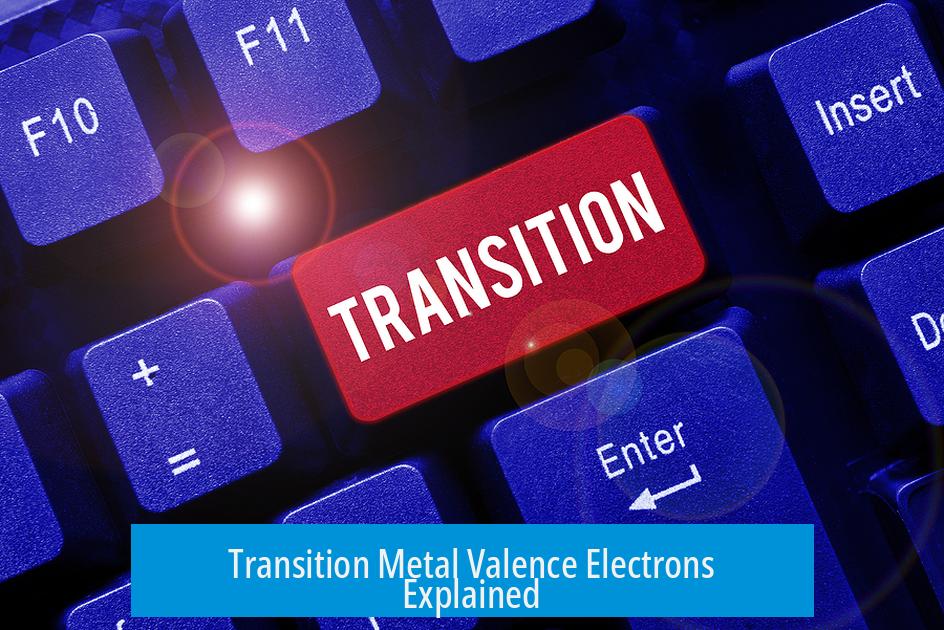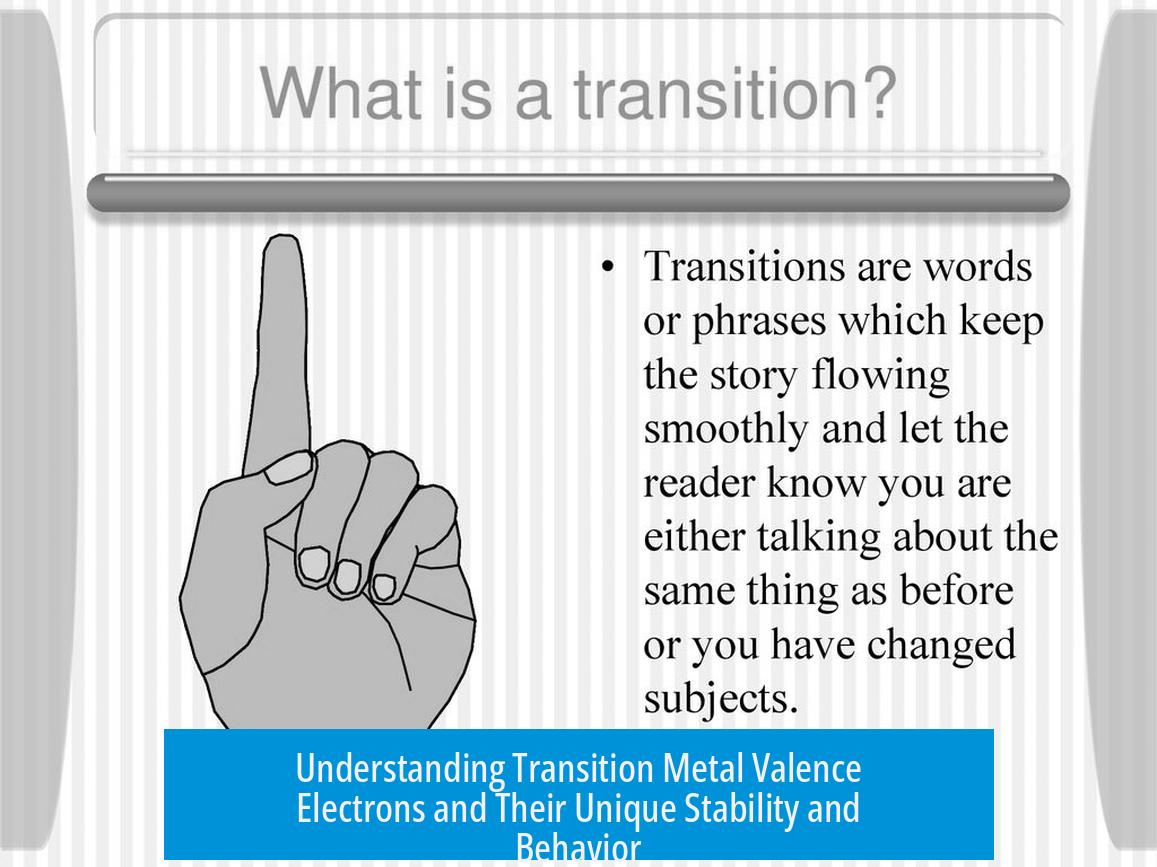Transition Metal Valence Electrons Explained

Transition metals exhibit a highly variable number of valence electrons, often ranging from 2 up to 12, depending on the element and its electron configuration. This variability makes simple counting methods ineffective, as it challenges standard valence electron concepts applied to other elements.
Understanding Valence Electrons in Transition Metals
Unlike main group elements, transition metals do not have a fixed number of valence electrons. Their valence shells include both the outermost s orbitals and the partially filled d orbitals inside the penultimate shell. This leads to more diverse electron counts.
- Transition metals often involve electrons from both (n-1)d and ns orbitals in bonding.
- Elements such as zinc (Zn), cadmium (Cd), and mercury (Hg) behave differently. Their filled d orbitals are highly stabilized, so they effectively contribute only their two ns electrons as valence electrons, similar to alkaline earth metals.
- Other transition metals can utilize up to 12 valence electrons when counting the d and s electrons together.
Electron Configuration and Stability

Transition metals show distinct preferences in electron configuration to achieve enhanced stability through specific d-orbital arrangements:
- Certain d-electron configurations, such as half-filled or fully filled d subshells, provide extra stability.
- Metals sometimes lose d-orbital electrons instead of higher-energy s-orbital electrons to reach these stable states.
- Ligand field theory helps explain this behavior by considering the effect of ligands on the metal’s orbital energies, which vary with the shape of the complex (e.g., tetrahedral, square planar).
Why Simple Valence Electron Rules Fail for Transition Metals
Common valence electron counting rules taught at basic levels do not adequately describe transition metals because of their complex atomic structure:
- Heavier elements and those with higher angular momentum electrons (like d and f orbitals) defy simplistic electron filling orders.
- The periodic trends seen in transition metals, lanthanides, and actinides incorporate quantum mechanical effects that significantly alter electron energy levels.
Energy Ordering of Orbitals
For transition metals, 4s and 3d orbitals have similar energies, unlike simple models that treat s orbitals as always lower in energy:
- Before scandium (Sc), 4s orbitals are lower in energy than 3d.
- From scandium onward, 3d orbitals become lower in energy and fill after the 4s orbitals, leading to complex electron configurations.
- This energy reversal explains why transition metals often lose their 4s electrons before 3d electrons during ionization.
Variable Oxidation States
Transition metals display a range of oxidation states due to the flexibility and energy proximity of the (n-1)d and ns electrons:
- Their ions can lose different numbers of electrons from 4s and 3d orbitals, resulting in oxidation states commonly from +1 up to +7 in some cases.
- Understanding why transition metals adopt particular oxidation states requires advanced quantum chemistry and ligand field theories.
- Popular simplified models often misrepresent the true nature of these ions.
Practical Implications
Transition metal chemistry often involves unpredictable electronic behavior caused by complex electron interactions:
- The canonical electron configurations are best treated as approximations helpful in predictions rather than definitive counts.
- Many properties, such as color, magnetism, and chemical reactivity, stem from the dynamic electron distributions among d and s orbitals.
- Ligand effects can further perturb the metal’s electron distribution.
Recommended Learning Approach
Given the quantum complexity, the following approach helps students and chemists tackle transition metal valence electrons:
- Focus initially on the simpler view that valence electrons include both ns and (n-1)d electrons.
- Accept that the exact count varies and is context-dependent, especially when considering complex formation.
- Avoid getting bogged down by detailed exceptions and quantum mechanical nuances until foundational concepts are mastered.
- Use ligand field and coordination chemistry as guides for explaining observed valence electron configurations in complexes.
Summary of Key Takeaways
- Transition metals do not have a fixed number of valence electrons; it ranges broadly due to involvement of d and s orbitals.
- Zinc, cadmium, and mercury are exceptions with only two effective valence electrons due to filled d orbitals.
- Electron configurations and valence electron counts vary with orbital stability and ligand environment.
- Orbital energy ordering changes across the transition series, affecting electron loss and oxidation states.
- Simple models often fail; detailed understanding requires higher-level quantum chemistry concepts.
- Focus on the general picture first, and progressively build knowledge with ligand field and coordination chemistry.
Transition Metal Valence Electrons: A Dive Into the Quirky World of Chemistry’s Rule-Benders
Transition metal valence electrons aren’t as simple as your textbook might want you to believe. Unlike elements in other blocks of the periodic table, transition metals don’t just have a fixed number of valence electrons—oh no, they like to keep chemists guessing with their variable electron counts and weird quirks. If you’ve ever wondered why chem students sometimes throw their hands up when these metals come up, you’re in the right place to unravel this mystery with a conversational, detailed guide.
Ready to explore? Let’s jump into the nitty-gritty of what makes transition metal valence electrons so special.
Why Are Their Valence Electrons Variable and Complicated?
Here’s the deal: transition metals are not your run-of-the-mill elements with simple electron counts. For most atoms, especially in Groups 1 and 2, valence electrons are easy to count—usually the outermost s or p electrons. But transition metals? They play by different rules, influenced heavily by their d orbitals.
One fact stands out immediately: “They do not only have two valence electrons but the number of valence electrons varies throughout the table.” This variability is the first curveball. For example, Zinc (Zn), Cadmium (Cd), and Mercury (Hg) mostly stick to two valence electrons, behaving somewhat like alkaline earth metals. But the other transition metals can juggle as many as twelve valence electrons, thanks to their d orbitals.
This variable count makes teaching transition metal valence electrons tricky. Professors sometimes dodge the messiness because these details can appear random without deeper quantum mechanics knowledge. So, the common approach? They say, “Ignore the quirks for now; it’ll get too confusing.”
The Role of d Orbitals in Stability
Why do transition metals have variable valence electron counts? It boils down to d orbital stability. Certain configurations of the d orbitals are more stable than others.
When a transition metal forms bonds or loses electrons, it tends to settle into these preferred, more stable d-electron arrangements. This means sometimes it sheds electrons from the outer s orbitals and sometimes even from the d orbitals, depending on which leads to a lower energy state.
Then there’s the factor of the molecule’s shape—tetrahedral, square planar, octahedral—all influencing the metal’s valence electron behavior through something called ligand field theory. (Don’t worry, you won’t be expected to master that without advanced chemistry classes.)
Why High School Rules Break Down Here
If you learned about valence electrons using simple “s and p blocks” strategies, congratulations! You got a great start—but those rules falter dramatically with heavier elements, including transition metals.
One reason is the complexity of electron angular momentum. As electrons fill different orbitals, their energy levels and spatial arrangements shift in ways the basic model can’t predict. So the transition metals, along with actinides and lanthanides, are notorious for “messing up” the neat periodic table order we like to imagine.
Close Energies of 4s and 3d Orbitals
One of the keys to understanding transition metals is realizing that the 4s and 3d orbitals have similar energy levels.
This similarity leads to interesting electron-filling patterns. For instance, electrons usually fill 4s orbital first, then 3d. But when transition metals ionize, electrons are lost from 4s before 3d, which feels backward if you think only about energy levels at a glance.
The Mystery of Why Not All Transition Metals Form 2+ Ions
You might have learned that many transition metals lose their 4s electrons to form +2 ions. But—for the curious—the energy of 3d orbitals actually becomes lower than 4s after scandium, which means electrons in 4s pop off first.
This flips the “rules” you might have learned earlier and is driven by some quantum mechanical jugglery involving angular momentum and electron distance from the nucleus. Because angular momentum and electron distance scale differently, electrons behave in unexpected ways in this zone of the periodic table.
Variable Oxidation States: The Quantum Puzzle Box
Transition metals are famous for their ability to take on multiple oxidation states, a feature essential to many catalytic and redox reactions in chemistry.
But why do they change charges so easily? To be honest, the complete explanation is super complex and generally understood only at the PhD level. The quick takeaway is: your mental image of a transition metal ion, like a simple +2 charge with fixed valence electrons, is likely very wrong. The actual electron environment is a dynamic battle of orbital energies, ligand effects, and electron correlation.
The Smarter Way to Learn About Transition Metal Electrons
Here’s some solid advice: Initially, accept that transition metal valence electrons are complicated and beyond simple memorization.
Yes, it might feel like dodging the challenge, but most properties can’t be predicted with simple rules. Instead, focus first on broad patterns, like their typical oxidation states or common electron configurations.
As you advance, embrace models like ligand field theory and quantum chemistry. But for now, it’s perfectly fine—and wise—to acknowledge, “They’re complicated; ignore the tricky bits until you’re ready.”
Wrapping It Up: The Beauty of Complexity in Transition Metals
Transition metal valence electrons are a beautiful mess. Their flexibility and variety allow metals like iron, copper, and platinum to do chemical tricks no other elements can. This complexity is why they are central to catalysis, electronic devices, and colorful compounds.
So, instead of fearing transition metals’ complicated electron stories, consider this: their quirks are what make them chemically fascinating and practically valuable.
Curious to explore more curious cases? Look up coordination complexes or the infamous variable oxidation states of vanadium and manganese. Chemistry nerd heaven!
To sum up, transition metal valence electrons vary widely, influenced by d-orbital configuration stability, quantum effects, and molecular surroundings. Don’t expect a simple formula. Instead, enjoy the journey of understanding these elemental enigmas step by step.
What determines the number of valence electrons in transition metals?
The number varies depending on the element. Most transition metals can have up to 12 valence electrons, but some like zinc, cadmium, and mercury mainly show two due to filled d-orbitals.
Why do transition metals have various stable d-orbital configurations?
The stability depends on the electron arrangement in d orbitals. Metals often adjust their electrons to reach more stable configurations, influenced by the shape of the complex formed with ligands.
Why don’t simple electron configuration rules always apply to transition metals?
Simple models break down due to the effects of angular momentum and energy levels in heavier elements. Transition metals and similar elements show complex behaviors that defy basic rules.
How do 4s and 3d orbitals affect the valence electrons in transition metals?
The 4s and 3d orbitals have similar energy levels. This similarity influences how electrons fill these orbitals and determines the valence electron count.
Why do not all transition metals commonly form 2+ ions?
After Scandium, 3d orbitals become lower in energy than 4s orbitals. This affects ion formation because electrons from 4s orbitals are lost first, but the details depend on quantum mechanics factors.
Is it easy to predict oxidation states of transition metals?
No. Their variable charges arise from complex quantum effects. Fully understanding oxidation states requires advanced knowledge beyond basic chemistry.





Leave a Comment